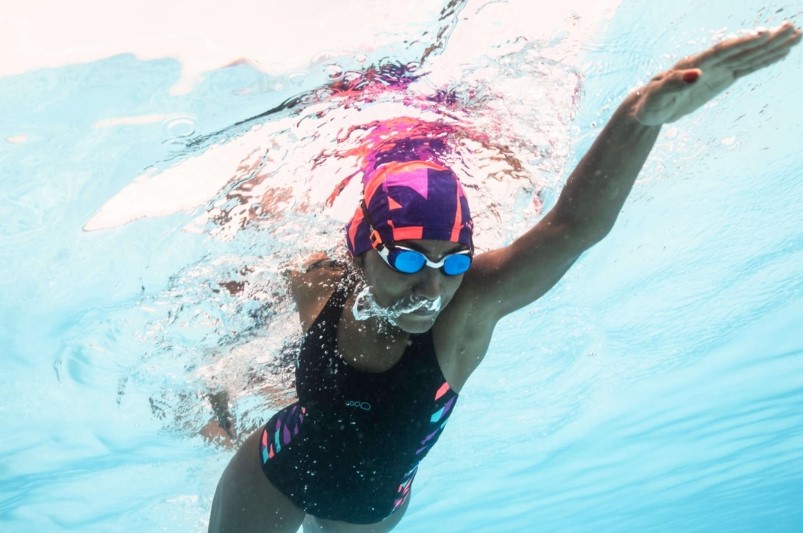How to Stop Water From Getting Into Your Nose while Swimming

When you’re learning how to swim, one of the most frustrating things is getting water up your nose. You can’t breathe and it’s scary. Fortunately, there are ways to prevent this from happening! Let me show you how:
Tip 1: Take a Long Slow Breath in Through Your Nose, and Then Out Through Your Mouth Before You Tip Your Head Backward and Immerse It in the Water
First and foremost, when you get into the pool or ocean, take a deep breath in through your nose. Hold it in for as long as possible—at least 8 seconds. Once you’ve held that breath for an extended period of time, tilt your head back and put it under water. The longer you can hold your breath underwater without exhaling or inhaling (known as “holding” a breath), the better off you’ll be: the less time there is between breaths means less chance for water to enter your nose during inhalation.
Next, breathe out slowly through your mouth while keeping most of the air inside of yourself. Afterward, simply repeat this process until all of the air has been expelled from within yourself—it’ll make sure that any excess moisture on either side of your nostrils doesn’t get introduced into them while they’re submerged underwater!
Tip 2: Tilt Your Head to the Side When You Submerge It

Source: unsplash.com
The second tip is to tilt your head to the side when putting it underwater. This will help ensure that only one nostril is submerged, which reduces the risk of water going up your nose.
You can also try tilting your head forwards when submerging it, but this increases the risk of water going up your nose, so only do this if you’re very confident about keeping water out of both nostrils.
Tip 3:Hold Your Nose With One Hand to Prevent Any Water From Getting Up There
- This is a simple maneuver that will help keep water out of your nose.
- Don’t worry about what the other hand does, as long as it is not holding your nose shut or anything like that.
Tip 4: Practice, practice, practice!
If you want to avoid water up the nose, practice is key. Practice in the shower, practice with a friend or family member who is willing to help you practice, and if possible, go swimming!
The more challenging aspects of snorkeling are breathing through your mouth while keeping your head above water. If you’ve ever tried this before then you know it’s not always easy! By practicing in pools and other shallow bodies of water (such as at a beach), you can get used to these movements so that they become second nature when you’re snorkeling deep under the sea.
Breathing Techniques for Swimming Beginners

Source: goingswimmingly.london
The most common method for avoiding water up the nose is by using deep breathing.
- Take a deep breath in, then let out. Make sure you’re actually taking in air and not just sucking in the water!
- Put your head underwater and hold it there for several seconds (about 10 or so). You may need to practice this a few times before you get used to it, but once you do it will become natural and easy!
- The next step is optional: If possible, keep one hand held tightly over your nose while doing this next part. This will help prevent any unwanted material from going up there!
Swimming Breathing Drills
Breathing drills are designed to help you breathe more efficiently while swimming, which will make you a better swimmer.
By practicing these drills regularly and incorporating them into your workout routine, you’ll be able to improve your endurance and streamline your stroke.
It doesn’t matter if you’re just starting out or if you’ve been competing for years—breathing drills are beneficial for all swimmers.
Nose plugs and Nose clips
Nose plugs and nose clips are two different options for keeping water from going up your nose when you’re diving.
Nose plugs are made of silicone, which is used to make other products like breast implants and pacifiers. They’re available in a variety of shapes, sizes and colors. Nose clips are made of plastic, which is also used to make everything from toys to toothbrushes (and even the occasional pacifier).
Nose plugs work by blocking off your nostrils so water won’t get inside them; nose clips work by pushing the sides of your nostrils together to prevent water from getting inside your nostrils as well. Both can be bought at most swim shops or online retailers such as Amazon.
Taking a Deep Breath Before Putting Your Head Underwater is an Easy Way to Prevent Water Up the Nose

Source: decathlon.in
Taking a deep breath before putting your head underwater is an easy way to prevent water up the nose.
It’s important to take a deep breath before putting your head underwater.
Conclusion
Hopefully, this article has given you some ideas on how to avoid having water up your nose. Are you a new swimmer and afraid of getting water up your nose? Swimming is one of the best sports, but it can be stressful if you’re worried about getting water up your nose. We’ve all been there!
And we don’t just mean because you’re new to swimming. Even the best swimmers have been fearful in the past that they might get water up their noses when they least expected it. The solution is simple to join swimrightacademy.com.
